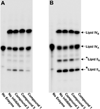Synthesis of and evaluation of lipid A modification by 4-substituted 4-deoxy arabinose analogs as potential inhibitors of bacterial polymyxin resistance
- PMID: 18187325
- PMCID: PMC2516481
- DOI: 10.1016/j.bmcl.2007.12.061
Synthesis of and evaluation of lipid A modification by 4-substituted 4-deoxy arabinose analogs as potential inhibitors of bacterial polymyxin resistance
Abstract
Three sets of novel 4-deoxy-l-arabinose analogs were synthesized and evaluated as potential inhibitors of the bacterial resistance mechanism in which lipid A, on the outer membrane, is modified with 4-amino-4-deoxy-l-arabinose (l-Ara4N). One compound diminished the transfer of l-Ara4N onto lipid A. These results suggest that small molecules might be designed that would effect the same reversal of bacterial resistance observed in genetic knockouts.
Figures





Similar articles
-
A formyltransferase required for polymyxin resistance in Escherichia coli and the modification of lipid A with 4-Amino-4-deoxy-L-arabinose. Identification and function oF UDP-4-deoxy-4-formamido-L-arabinose.J Biol Chem. 2005 Apr 8;280(14):14154-67. doi: 10.1074/jbc.M414265200. Epub 2005 Jan 28. J Biol Chem. 2005. PMID: 15695810
-
An undecaprenyl phosphate-aminoarabinose flippase required for polymyxin resistance in Escherichia coli.J Biol Chem. 2007 Dec 7;282(49):36077-89. doi: 10.1074/jbc.M706172200. Epub 2007 Oct 10. J Biol Chem. 2007. PMID: 17928292 Free PMC article.
-
An inner membrane enzyme in Salmonella and Escherichia coli that transfers 4-amino-4-deoxy-L-arabinose to lipid A: induction on polymyxin-resistant mutants and role of a novel lipid-linked donor.J Biol Chem. 2001 Nov 16;276(46):43122-31. doi: 10.1074/jbc.M106961200. Epub 2001 Sep 4. J Biol Chem. 2001. PMID: 11535604
-
Untying the anchor for the lipopolysaccharide: lipid A structural modification systems offer diagnostic and therapeutic options to tackle polymyxin resistance.Arh Hig Rada Toksikol. 2023 Sep 30;74(3):145-166. doi: 10.2478/aiht-2023-74-3717. eCollection 2023 Sep 1. Arh Hig Rada Toksikol. 2023. PMID: 37791675 Free PMC article. Review.
-
Mechanisms of Polymyxin Resistance.Adv Exp Med Biol. 2019;1145:55-71. doi: 10.1007/978-3-030-16373-0_5. Adv Exp Med Biol. 2019. PMID: 31364071 Review.
Cited by
-
Extreme antimicrobial peptide and polymyxin B resistance in the genus Burkholderia.Front Cell Infect Microbiol. 2011 Jul 22;1:6. doi: 10.3389/fcimb.2011.00006. eCollection 2011. Front Cell Infect Microbiol. 2011. PMID: 22919572 Free PMC article. Review.
-
Extreme antimicrobial Peptide and polymyxin B resistance in the genus burkholderia.Front Microbiol. 2011 Jul 22;2:159. doi: 10.3389/fmicb.2011.00159. eCollection 2011. Front Microbiol. 2011. PMID: 21811491 Free PMC article.
-
Comparison of Gene Expression Profiles of Uropathogenic Escherichia Coli CFT073 after Prolonged Exposure to Subinhibitory Concentrations of Different Biocides.Antibiotics (Basel). 2019 Sep 27;8(4):167. doi: 10.3390/antibiotics8040167. Antibiotics (Basel). 2019. PMID: 31569631 Free PMC article.
-
A Klebsiella pneumoniae DedA family membrane protein is required for colistin resistance and for virulence in wax moth larvae.Sci Rep. 2021 Dec 21;11(1):24365. doi: 10.1038/s41598-021-03834-3. Sci Rep. 2021. PMID: 34934166 Free PMC article.
-
The efficacy of anti-proteolytic peptide R7I in intestinal inflammation, function, microbiota, and metabolites by multi-omics analysis in murine bacterial enteritis.Bioeng Transl Med. 2022 Nov 8;8(2):e10446. doi: 10.1002/btm2.10446. eCollection 2023 Mar. Bioeng Transl Med. 2022. PMID: 36925697 Free PMC article.
References
-
- Beringer P. The clinical use of colistin in patients with cystic fibrosis. Curr Opin Pulm Med. 2001;7(6):434–440. - PubMed
-
- Brogden KA. Antimicrobial peptides: pore formers or metabolic inhibitors in bacteria? Nat Rev Microbiol. 2005;3(3):238–250. - PubMed
-
- Peschel A. How do bacteria resist human antimicrobial peptides? Trends Microbiol. 2002;10(4):179–186. - PubMed
-
- McPhee JB, Lewenza S, Hancock RE. Cationic antimicrobial peptides activate a two-component regulatory system, PmrA-PmrB, that regulates resistance to polymyxin B and cationic antimicrobial peptides in Pseudomonas aeruginosa. Mol Microbiol. 2003;50(1):205–217. - PubMed
-
- Bader MW, Navarre WW, Shiau W, Nikaido H, Frye JG, McClelland M, Fang FC, Miller SI. Regulation of Salmonella typhimurium virulence gene expression by cationic antimicrobial peptides. Mol Microbiol. 2003;50(1):219–230. - PubMed
Publication types
MeSH terms
Substances
Grants and funding
LinkOut - more resources
Full Text Sources
Other Literature Sources
Medical

